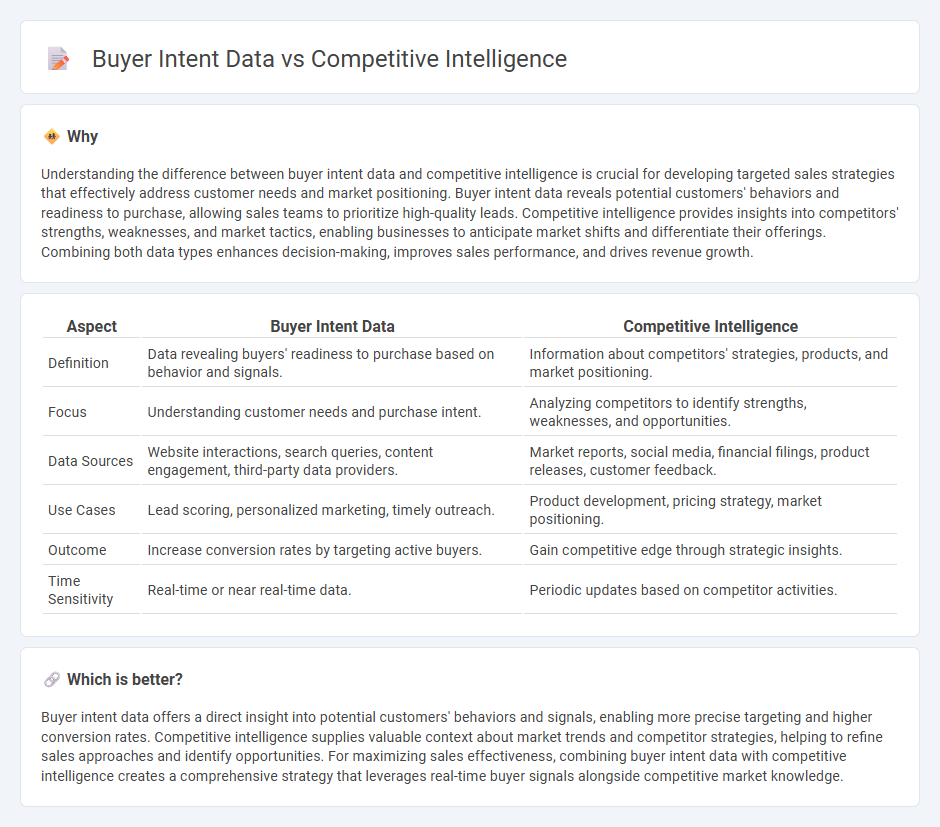
Buyer intent data captures signals indicating potential customers' readiness to purchase, enabling sales teams to prioritize leads with high conversion probability. Competitive intelligence gathers insights on competitor strategies, market trends, and pricing to inform sales tactics and positioning. Explore how leveraging both can enhance sales effectiveness and drive growth.
Why it is important
Understanding the difference between buyer intent data and competitive intelligence is crucial for developing targeted sales strategies that effectively address customer needs and market positioning. Buyer intent data reveals potential customers' behaviors and readiness to purchase, allowing sales teams to prioritize high-quality leads. Competitive intelligence provides insights into competitors' strengths, weaknesses, and market tactics, enabling businesses to anticipate market shifts and differentiate their offerings. Combining both data types enhances decision-making, improves sales performance, and drives revenue growth.
Comparison Table
| Aspect | Buyer Intent Data | Competitive Intelligence |
|---|---|---|
| Definition | Data revealing buyers' readiness to purchase based on behavior and signals. | Information about competitors' strategies, products, and market positioning. |
| Focus | Understanding customer needs and purchase intent. | Analyzing competitors to identify strengths, weaknesses, and opportunities. |
| Data Sources | Website interactions, search queries, content engagement, third-party data providers. | Market reports, social media, financial filings, product releases, customer feedback. |
| Use Cases | Lead scoring, personalized marketing, timely outreach. | Product development, pricing strategy, market positioning. |
| Outcome | Increase conversion rates by targeting active buyers. | Gain competitive edge through strategic insights. |
| Time Sensitivity | Real-time or near real-time data. | Periodic updates based on competitor activities. |
Which is better?
Buyer intent data offers a direct insight into potential customers' behaviors and signals, enabling more precise targeting and higher conversion rates. Competitive intelligence supplies valuable context about market trends and competitor strategies, helping to refine sales approaches and identify opportunities. For maximizing sales effectiveness, combining buyer intent data with competitive intelligence creates a comprehensive strategy that leverages real-time buyer signals alongside competitive market knowledge.
Connection
Buyer intent data reveals prospective customers' readiness to purchase by analyzing their online behavior and engagement patterns, which helps sales teams prioritize leads with higher conversion potential. Competitive intelligence provides insights into competitors' strategies, product offerings, and market positioning, enabling sales teams to tailor their approaches and differentiate effectively. Integrating buyer intent data with competitive intelligence empowers sales organizations to target prospects more accurately while anticipating competitor moves, maximizing deal win rates and overall revenue growth.
Key Terms
Competitive Intelligence:
Competitive intelligence involves gathering and analyzing data about competitors' strategies, strengths, weaknesses, and market positioning to make informed business decisions. It helps companies identify opportunities, anticipate market trends, and develop strategies to outperform rivals. Explore how leveraging competitive intelligence can give your business a strategic advantage.
Market Analysis
Competitive intelligence involves gathering and analyzing data about competitors' strategies, strengths, and weaknesses to inform market positioning and business decisions. Buyer intent data captures signals and behaviors indicating potential customers' interest, helping businesses tailor marketing efforts and predict purchase timing. Explore more to understand how integrating both enhances strategic market analysis and decision-making.
Competitor Benchmarking
Competitive intelligence involves gathering and analyzing data about competitors' strategies, strengths, and market positions to benchmark performance effectively. Buyer intent data reveals potential customers' behaviors and signals, helping to predict purchase decisions but offers limited direct insight into competitor activities. Explore further to understand how integrating both approaches can enhance your competitor benchmarking strategies.
Source and External Links
Competitive intelligence - Wikipedia - Competitive intelligence (CI) is the process of gathering, analyzing, and distributing knowledge about the competitive environment to improve organizational performance, focusing on external business factors like competitors, customers, and market trends to support strategic decision-making legally and systematically.
What Is Competitive Intelligence? Overview & How to Get It - Semrush - Competitive intelligence involves collecting and analyzing data on competitors, industry, and customers to identify opportunities and threats, benchmark performance, and inform strategic decisions, illustrated by examples like Microsoft Teams adapting to market shifts.
Competitive Intelligence - SJSU - School of Information - CI is a systematic process to gather, monitor, analyze, and disseminate external information of strategic value to assist decision-makers in recognizing competitive threats and opportunities, with CI specialists often embedded within or working for organizations across various industries.
 dowidth.com
dowidth.com